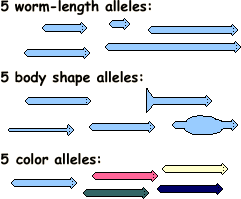Genetic Drift Simulation
About this simulation
Why use models?
|
Evolutionary events occur over long periods of time and at the molecular level. Because of this, it is very difficult to study evolution itself. To get around this, scientists often use simplified representations of nature called models. In order to interpret the results of a model, first you must have an understanding of how the model works and what its limitations are. |
About the model
|
This model of evolution uses imaginary organisms called Driftworms. This simulation allows you to visualize the evolution of color in a population of driftworms. We could just as easily be looking at another phenotype, such as body shape, number of eyes, or length. Color was chosen for practical reasons. |
 |
Haploid genomes
| Driftworms are haploid, like bacteria and many protozoa and algae. This simulation is also applicable to mitochondrial and chloroplast genes in many organisms; although these organelle genomes are not haploid, they can be treated as if they were for some purposes. |
Asexual reproduction
| Driftworms are asexual, in the sense that genes are inherited from a single parent and without recombination. Many protozoa and algae and some animals and plants are asexual; organelle genomes are often asexual; and sex in bacteria is rare. |
Non-overlapping generations
|
Driftworms have non-overlapping generations, producing a variable number of offspring simultaneously and then dying. Biological equivalents of this are annual plants or ground-nesting bees. Having non-overlapping generations simplifies simulation studies. Fortunately, it turns out that non-overlapping generations approximate overlapping generations in many ways. |
Constant population size
|
Our model also assumes a constant population size, N. This is also a good approximation for some organisms, but not those whose population size fluctuates wildly. |
How it works
|
The simulation program works like this. N is the population size, which is constant. The worms are numbered 1 through N. In each generation, the computer draws N random digits, from 1 through N, which determine how many offspring each individual will leave in the next generation. This simulates drift.
For example, in the graphic to the right, N = 5. The computer randomly drew a number from 1 to 5, five times. In this case, the computer drew the numbers 1, 5, 4, 3, and 1. Parent 1 had two offspring. Parents 3, 4, and 5 each had one offspring. |
Manual version of the simulation
| It may help your understanding of this computer model to do a manual version of the driftworms simulation. Your teacher may want to skip the Manual Version. If so, follow the Driftworm Simulation link below. |
<< What is Genetic Drift? | Driftworm Simulation >>
The University of Arizona
April 27, 1999
Contact the Development Team
http://www.biology.arizona.edu
All contents copyright © 1998. All rights reserved.
